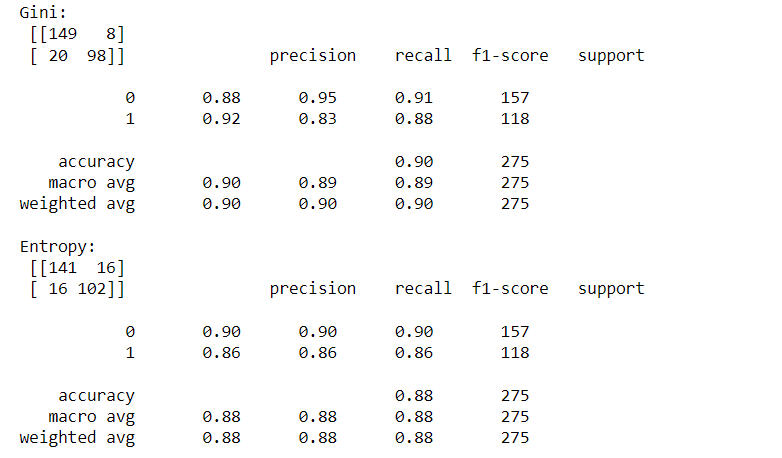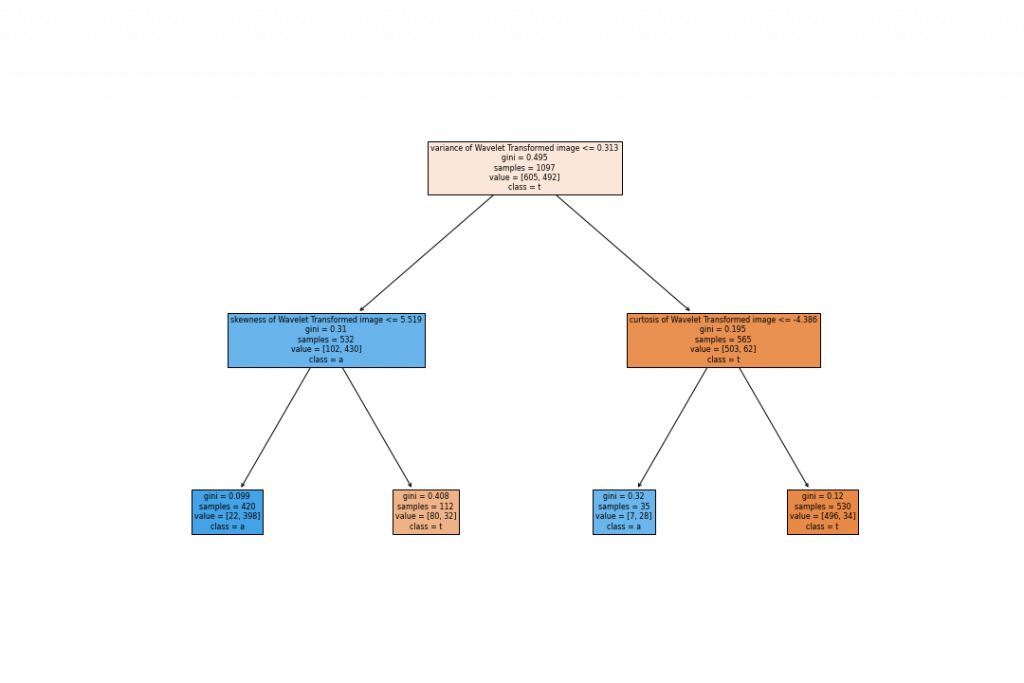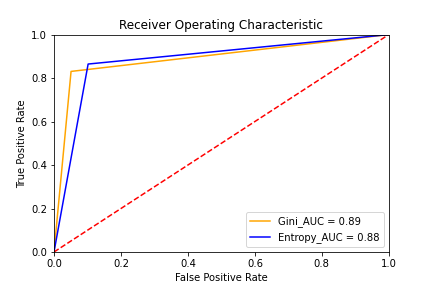今日大綱
範例所使用的程式碼與支持向量機範例一樣,為分辨真偽鈔來自UCI的資料集
先將需要用到的library與資料匯入
import pandas as pd
from sklearn.model_selection import train_test_split
from sklearn.tree import DecisionTreeClassifier
from sklearn.metrics import confusion_matrix, classification_report
url = 'https://archive.ics.uci.edu/ml/machine-learning-databases/00267/data_banknote_authentication.txt'
columns = ['variance of Wavelet Transformed image', 'skewness of Wavelet Transformed image', 'curtosis of Wavelet Transformed image', 'entropy of image', 'target']
data = pd.read_csv(url, names = columns)
接著,將資料分割成訓練集與測試集
x = data.iloc[:,:-1]
y = data.iloc[:, -1]
x_train, x_test, y_train, y_test = train_test_split(x, y, test_size = 0.2, random_state = 1)
分別訓練利用Gini與Entropy當作切割標準的決策樹
clf_gini = DecisionTreeClassifier(criterion = "gini",
random_state = 100,max_depth=2)
clf_entropy = DecisionTreeClassifier(criterion = "entropy",
random_state = 100,max_depth=2)
clf_gini.fit(x_train, y_train)
prediction_gini = clf_gini.predict(x_test)
clf_entropy.fit(x_train, y_train)
prediction_entropy = clf_entropy.predict(x_test)
印出兩個決策樹的結果
from sklearn.metrics import confusion_matrix, classification_report
print("Gini: \n", confusion_matrix(y_test, prediction_gini), classification_report(y_test, prediction_gini))
print("Entropy: \n", confusion_matrix(y_test, prediction_entropy), classification_report(y_test, prediction_entropy))

從結果可以發現,利用gini impurity為標準組成的決策樹準確率較高
視覺化利用Gini組成的決策樹
import matplotlib.pyplot as plt
from sklearn import tree
fig = plt.figure(figsize=(15,10))
_ = tree.plot_tree(clf_gini,
feature_names=x_train.columns,
class_names='target',
filled=True)
fig.savefig("gini.png")

視覺化利用entropy組成的決策樹
fig = plt.figure(figsize=(15,10))
_ = tree.plot_tree(clf_entropy,
feature_names=x_train.columns,
class_names='target',
filled=True)
fig.savefig("entropy.png")

最後畫出兩個模型的ROC,並且算出AUC
from sklearn.metrics import roc_curve, roc_auc_score, auc
plt.title('Receiver Operating Characteristic')
# 在各種『決策門檻』(decision threshold)下,計算 『真陽率』(True Positive Rate;TPR)與『假陽率』(False Positive Rate;FPR)
fpr, tpr, threshold = roc_curve(y_test, prediction_gini)
auc = round(roc_auc_score(y_test, prediction_gini), 2)
plt.plot(fpr, tpr, color = 'orange', label = 'Gini_AUC = %0.2f' % auc)
fpr, tpr, threshold = roc_curve(y_test, prediction_entropy)
auc = round(roc_auc_score(y_test, prediction_entropy), 2)
plt.plot(fpr, tpr, color = 'blue', label = 'Entropy_AUC = %0.2f' % auc)
## Plot the result
plt.legend(loc = 'lower right')
plt.plot([0, 1], [0, 1],'r--')
plt.xlim([0, 1])
plt.ylim([0, 1])
plt.ylabel('True Positive Rate')
plt.xlabel('False Positive Rate')
plt.show()

從圖可看出,不管是Accuracy或是AUC,使用Gini impurity的效果比較好。
程式碼已上傳我的Github
感謝您的瀏覽,我們明天見!![]()
